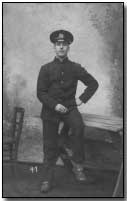Memoirs & Diaries - Dead For 44 Years
 Tommy Henderson was
officially dead for five months - and he has got a certificate to prove it.
The certificate says he was killed in action with the West Yorkshire Regt.
in France on July 1, 1916. That was the day of the Battle of the Somme
when the Allies lost 500,000 men.
Tommy Henderson was
officially dead for five months - and he has got a certificate to prove it.
The certificate says he was killed in action with the West Yorkshire Regt.
in France on July 1, 1916. That was the day of the Battle of the Somme
when the Allies lost 500,000 men.
On a similarly warm day in July 44 years later, a live and active Tommy Henderson tended his dahlias at 2, Hearfield Cottages, First-lane, Hessle, and recalled that bloody day on the Somme.
"The officer came along and said, 'We will go over the top today lads' - just like that.
"We had to follow a white tape that had been laid out the night before; advance, then do a right flanking attack that was going to wipe out a couple of Jerry trench lines.
"I was on the machinegun. The officer said to me, 'I want to hear you work that well.' 'Yes,' I said. I'd had two spoonsful of rum.
"Well, we got up to the Jerry lines, but there was no one in them so we continued advancing. What we didn't know was that the Germans had dug subterranean tunnels 40ft down. They left one man up in the trenches to communicate what was happening.
"We couldn't go back because we would have run into our own bombardments, so we were trapped in the German lines," said Tommy.
While his mother was reading a report that he had been killed in action, Tommy was being marched off to a prisoner-of-war camp in Westphalia. There he was forced to work in Krupp's coalmines. "The working conditions were fair if you were a miner but they were terrible for a seaman like me," said Tommy.
Escape
He spent a year planning to escape. With two pals he was able to put a simple but effective plan into operation. The cage taking them down into the mines was divided into three tiers. While going to work one winter's morning the three men entered the top tier of the cage. When the first tier reached the working level of the mine, Tommy and his pals climbed up on to the roof of the cage.
As soon as the cage returned to ground level, the three prisoners were able to hide in the rigging of the lift shaft and later to make their escape. After days of marching by night and hiding when it was light, they finally reached the Dutch border. Freedom was only 100yds away, but in between lay patrolling German sentries.
 Waiting until nightfall,
they agreed to slip past the sentries one by one. The first to try was
a small Glasgow lad, but before he could get far he collided with a trip
wire.
Waiting until nightfall,
they agreed to slip past the sentries one by one. The first to try was
a small Glasgow lad, but before he could get far he collided with a trip
wire.
"We'd had it then" said Tommy. "As soon as they heard those tincans rattling the guards started to search the area, calling for us to give ourselves up. "They were jabbing their bayonets into every patch of cover there was, so we came out with our arms up."
Pte. Henderson was taken back to the prison camp, where he was beaten up by Prussian guards and where he remained until the end of the war.
"One day, the guards all suddenly ran off and left us, so we knew the war was over," he recalled.
The British P.O.W.'s burnt all their possessions to make sure nothing was left for the defeated Germans, formed up in column and marched off to Holland.
Home Again
On November 27, 1918, Tommy Henderson landed at Riverside Quay from Rotterdam, to prove that the letters he had sent to his mother to say he was alive were true.
Now a 66-year-old pensioner, Tommy Henderson passes his time converting his backyard into a riot of colour by planting flowers in every box, bucket, pot and pan he can obtain.
The man who "died" and came back to life again, remembers his experience with a laugh - "we never paid back the insurance money my mother collected."
First published in the Hull Daily Mail in 1960; article courtesy of Greg O'Beirne (Tommy Henderson's great-grandson)
"Boche" was a disparaging term used to describe anything German.
- Did you know?
